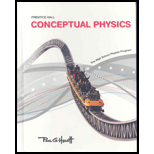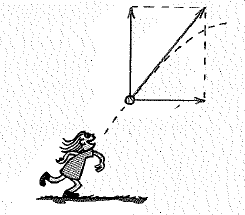
Concept explainers
a. How far below an initial straight-line path will a projectile fall in one second?
b. Does your answer depend on the angle of launch or on the initial speed of the projectile? Defend your answer.

(a)
The distance below an initial straight-line path travelled by projectile while falling off.
Answer to Problem 10A
The distance below an initial straight-line path travelled by projectile while falling off is
Explanation of Solution
Given:
The time period is
Formula used:
The expression for equation of motion under constant acceleration is,
Here,
Calculation:
Consider the acceleration due to gravity as
The distance below an initial straight-line path will a projectile fall in one second is,
Conclusion:
Thus, the distance below an initial straight-line path travelled by projectile while falling off in one second is
(b)
To identify:Whether the distance travelled obtained in part (a) depends on the angle of launch or on the initial speed of the projectile.
Answer to Problem 10A
The distance neither depend on the angle of launch nor on the initial speed of the projectile.
Explanation of Solution
Given:
The time period is
Formula used:
The expression for equation of motion under constant acceleration is,
Here,
Calculation:
The expression for vertical distance below the line is,
Here,
The equation of vertical distance is not relative to the angle of launch or the initial speed of the projectile. It is relative to the acceleration due to gravity and the time.
Conclusion:
Thus, the distance doesn’t depend on the angle of launch or on the initial speed of the projectile.
Chapter 5 Solutions
Conceptual Physics: The High School Physics Program
Additional Science Textbook Solutions
Applied Physics (11th Edition)
University Physics (14th Edition)
College Physics: A Strategic Approach (3rd Edition)
An Introduction to Thermal Physics
Physics for Scientists and Engineers: A Strategic Approach with Modern Physics (4th Edition)
 College PhysicsPhysicsISBN:9781305952300Author:Raymond A. Serway, Chris VuillePublisher:Cengage Learning
College PhysicsPhysicsISBN:9781305952300Author:Raymond A. Serway, Chris VuillePublisher:Cengage Learning University Physics (14th Edition)PhysicsISBN:9780133969290Author:Hugh D. Young, Roger A. FreedmanPublisher:PEARSON
University Physics (14th Edition)PhysicsISBN:9780133969290Author:Hugh D. Young, Roger A. FreedmanPublisher:PEARSON Introduction To Quantum MechanicsPhysicsISBN:9781107189638Author:Griffiths, David J., Schroeter, Darrell F.Publisher:Cambridge University Press
Introduction To Quantum MechanicsPhysicsISBN:9781107189638Author:Griffiths, David J., Schroeter, Darrell F.Publisher:Cambridge University Press Physics for Scientists and EngineersPhysicsISBN:9781337553278Author:Raymond A. Serway, John W. JewettPublisher:Cengage Learning
Physics for Scientists and EngineersPhysicsISBN:9781337553278Author:Raymond A. Serway, John W. JewettPublisher:Cengage Learning Lecture- Tutorials for Introductory AstronomyPhysicsISBN:9780321820464Author:Edward E. Prather, Tim P. Slater, Jeff P. Adams, Gina BrissendenPublisher:Addison-Wesley
Lecture- Tutorials for Introductory AstronomyPhysicsISBN:9780321820464Author:Edward E. Prather, Tim P. Slater, Jeff P. Adams, Gina BrissendenPublisher:Addison-Wesley College Physics: A Strategic Approach (4th Editio...PhysicsISBN:9780134609034Author:Randall D. Knight (Professor Emeritus), Brian Jones, Stuart FieldPublisher:PEARSON
College Physics: A Strategic Approach (4th Editio...PhysicsISBN:9780134609034Author:Randall D. Knight (Professor Emeritus), Brian Jones, Stuart FieldPublisher:PEARSON





